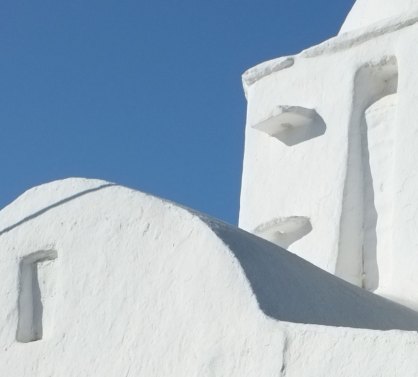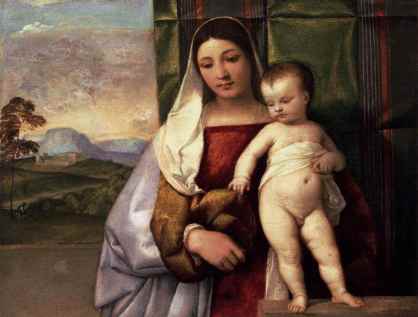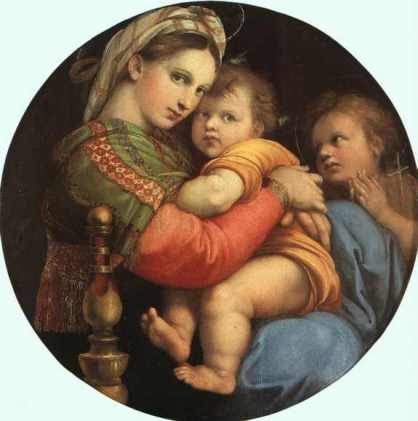 I was for a few days on the island of Paros, Greece, where one night I saw under the weak lunar light the Aegean Sculpture I present today. The white church looked like something much more than a religious building, and I pronounced it “a sculpture”. Next morning I went to the village in order to photograph the “sculpture”. It was there, bathed in the morning sunlight, in the middle of the small community that was still resting. This emotional experience led me to present the church as sculpture and sculpture as a working work of art, in the sense originally discussed by Martin Heidegger.
I was for a few days on the island of Paros, Greece, where one night I saw under the weak lunar light the Aegean Sculpture I present today. The white church looked like something much more than a religious building, and I pronounced it “a sculpture”. Next morning I went to the village in order to photograph the “sculpture”. It was there, bathed in the morning sunlight, in the middle of the small community that was still resting. This emotional experience led me to present the church as sculpture and sculpture as a working work of art, in the sense originally discussed by Martin Heidegger.
I find particularly interesting the notion of a “working” work of art, in the sense that it is a work that participates and in a way effects and reflects real life. I will therefore quote extensively from Heidegger’s work but also from scholars who have tried to interpret Heidegger after his “turn” to aesthetics and art.
I will conclude with some thoughts on the significance of the Aegean Sculpture in the context of the ever developing Greek drama, a combination of financial and cultural bankruptcy.
{In his article, “The Origin of the Work of Art” Heidegger explains the essence of art in terms of the concepts of being and truth. He argues that art is not only a way of expressing the element of truth in a culture, but the means of creating it and providing a springboard from which “that which is” can be revealed. Works of art are not merely representations of the way things are, but actually produce a community’s shared understanding. Each time a new artwork is added to any culture, the meaning of what it is to exist is inherently changed.}
(Source: Wikipedia)
{Heidegger’s basic insight is that the work of art not only manifests the style of the culture; it articulates it. For everyday practices to give us a shared world, and so give meaning to our lives, they must be focused and held up to the practitioners. Works of art, when performing this function, are not merely representations of a pre-existing state of affairs, but actually produce a shared understanding.}
(Source: Hubert L. Dreyfus, Heidegger on Art)
 Heidegger articulates his thoughts by discussing an ancient Greek Temple:
Heidegger articulates his thoughts by discussing an ancient Greek Temple:
{It is the temple work that first fits together and at the same time gathers around itself the unity of those paths and relations in which birth and death, disaster and blessing, victory and disgrace, endurance and decline acquire the shape of destiny for human being….(The temple thus) gave things their look and men their outlook on themselves.}
(Source: Martin Heidegger, The Origin of the Work of Art)
{Heidegger is considering art in terms of its cultural founding significance, and cultural founding art work acts as a paradigm for the event of truth’s happening. The happening of truth is described as the projection of truth, and all art is defined by Heidegger as Dichtung, or poetry. However, this does not restrict the definition of Dichtung to include only the linguistic expression of “poetry.” Rather, he envisages Dichtung as referencing all creative, projective events of truth’s happening. Therefore, Dichtung occurs in many forms of art: painting, sculpture, architecture, music, and poetry. Due to art’s unique nature, it opens the space of disclosure in such a way that it “breaks open an open place, in whose openness everything is other than usual.”34 Heidegger stresses the potential of great art to ecstatically displace Dasein from the realm of its everyday, ordinary ways of existing by transforming “anew” its accustomed ties to the world and Earth.}
(Source: James Magrini, The Work of Art and Truth of Being as “Historical”: Reading Being and Time, “The Origin of the Work of Art,” and the “Turn” (Kehre) in Heidegger’s Philosophy of the 1930s)
The work of art is not something that works out its truth merely by laying it bare and plain for all to see. On the contrary, great works of art outshine others in their unfathomableness, (i.e. their depth). That is, anything which lends itself to conveniently summed up—described and explained away—is not thus preserved in its being let ‘stand-initself’, but rather leveled off and disabled in its capacity for bringing about wonder and estrangement; it is dragged down in connoisseurship to the realm of commonality (i.e. the unextraordinary) and commodity (i.e. the ‘art business’). It is masticated so as to be served up as fodder for idle talk.
(Source: Shawn Moi, Perplexity and Passion in Heidegger)
In the Heideggerian framework of viewing Art, the Ancient Greek Temple is “non-working Art”, in the sense that the work of art no longer has and maintains a dynamic interplay with the surrounding community. the reasonable question that emerges having seen the Aegean sculpture, is:
Is the Aegean sculpture working art, in the sense that it performs the three essential functions? (see Dreyfus):
- Manifesting a World
- Articulating a culture’s understanding of Being
- Reconfiguring a culture’s understanding of Being
I believe it is, and as long as it remains, I also believe that there is hope in the contemporary drama of Greece.
The hope is that Greeks will eventually accept to be themselves (ourselves) and stop trying to become a pathetic immitation of others. There is no survival without identity, and the Aegean Sculpture is part of the Greek’s multifaceted identity. The acceptance of identity will also start the process of maintaining it and embellishing it, and this is where the Aegean Sculpture also comes in, with its stunning simplicity and harmony of being an integral part of the space around it.
The white structure engages the blue sky and the sea of the Aegean in an eternal embrace.
Its whiteness pays tribute to the famous marble of Paros, but beats it at the same time, as its humble and simple material reminds us that we can do wonderful things, and thus be wonderful ourselves with very “cheap” materials. The Aegean Sculpture could never be made of gold, or covered with precious stones. It would not be itself.













































































 In one of the spectacular panels of the church, the Emperor who made Ravenna the capital of Byzantium in the West is seen with his entourage and Bishop Maximian.
In one of the spectacular panels of the church, the Emperor who made Ravenna the capital of Byzantium in the West is seen with his entourage and Bishop Maximian. The Church was dedicated to Bishop Maximian in 547 and he is the nly named figure in the panel.
The Church was dedicated to Bishop Maximian in 547 and he is the nly named figure in the panel. In another panel, we see a young, beardless Christ
In another panel, we see a young, beardless Christ giving the crown of martyrdom to St. Vitalis, while Bishop Exxlesius is presenting a model of the Church. Ecclesius was the Bishop who started the building of the Chuch in 526.
giving the crown of martyrdom to St. Vitalis, while Bishop Exxlesius is presenting a model of the Church. Ecclesius was the Bishop who started the building of the Chuch in 526. The representation of Agnus Dei, the Lamb of God is stunning.Agnus Dei is the allegorical representation of the “Sacrifice” of Christ.
The representation of Agnus Dei, the Lamb of God is stunning.Agnus Dei is the allegorical representation of the “Sacrifice” of Christ.

 The mosais on the Arches are by themselves masterpieces.
The mosais on the Arches are by themselves masterpieces. What a wonsderful depiction of our Saviour! Encircled by four dolphins!
What a wonsderful depiction of our Saviour! Encircled by four dolphins! This decorative detail is the best testimony to the absolute glory of the church’s mosaics.
This decorative detail is the best testimony to the absolute glory of the church’s mosaics. Empress Theodora and her friends.
Empress Theodora and her friends. The church is full of symbolic images, figures and episodes from the Testament.
The church is full of symbolic images, figures and episodes from the Testament. Abel and Melchizedek.
Abel and Melchizedek. San Vitale is a treasure that cannot be exhaused easily. I feel I need to go back again and again. Same feeling I had in Moni Choras.
San Vitale is a treasure that cannot be exhaused easily. I feel I need to go back again and again. Same feeling I had in Moni Choras.

